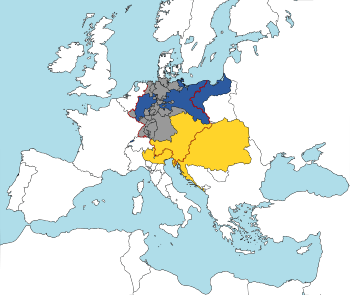German Confederation facts for kids
Quick facts for kids
German Confederation
Deutscher Bund
|
|||||||||||||||||||||||||
|---|---|---|---|---|---|---|---|---|---|---|---|---|---|---|---|---|---|---|---|---|---|---|---|---|---|
| 1815–1866 | |||||||||||||||||||||||||

The German Confederation in 1820. The two major powers - the Austrian Empire (yellow) and the Kingdom of Prussia (blue) - were not totally enclosed by the confederation's borders (red)
|
|||||||||||||||||||||||||
| Capital | Free City of Frankfurt | ||||||||||||||||||||||||
| Presidency | |||||||||||||||||||||||||
| Federal Assembly | |||||||||||||||||||||||||
| History | |||||||||||||||||||||||||
| June 8 1815 | |||||||||||||||||||||||||
|
• Disestablished
|
August 23 1866 | ||||||||||||||||||||||||
| ISO 3166 code | DE | ||||||||||||||||||||||||
|
|||||||||||||||||||||||||
The German Confederation was a group of 39 independent German-speaking states. These states came together in Central Europe after the Holy Roman Empire ended in 1806. It was formed in 1815 at the Congress of Vienna. This meeting of European leaders aimed to bring peace and stability back to Europe after the Napoleonic Wars.
Before the Confederation, Germany was made up of over 300 very small kingdoms. These tiny states were not strong enough to protect themselves. France, under Napoleon, had easily taken them over. The Congress of Vienna wanted to create a stronger group of states. This would help prevent future invasions.
The leaders decided to combine the many small countries into 39 larger ones. These 39 countries then formed a confederation. A confederation means that each country was still separate and ruled itself. However, they agreed to work together, especially to defend each other. They acted like one big country in some ways, but they were not truly united. The Confederation was designed to be strong enough to defend itself, but not strong enough to attack other countries.
Contents
The Confederation's Purpose and Structure
The main goal of the German Confederation was to keep peace and balance in Europe. It also aimed to protect the independence of its member states. The two most powerful members were the Austrian Empire and the Kingdom of Prussia. These two countries often competed for influence within the Confederation.
How the Confederation Was Governed
The Confederation was led by a group called the Federal Assembly. This assembly met in the city of Frankfurt am Main. Each member state sent representatives to this assembly. Austria usually held the presidency, meaning it led the meetings. Decisions in the Federal Assembly were often slow. This was because all 39 states had to agree on important matters.
Life in the German Confederation
During this time, many people in the German states wanted more freedom and a united Germany. They hoped for a single, strong German nation. However, the leaders of the Confederation, especially Klemens von Metternich from Austria, wanted to keep things as they were. They tried to stop ideas of revolution and unity. Despite this, there were important changes. Cities grew, and universities became centers for new ideas.
The End of the German Confederation
The German Confederation lasted for about 51 years. It ended in 1866 because of growing rivalries between its members. The biggest conflict was between Austria and Prussia. Both wanted to be the most powerful German state. This led to the Austro-Prussian War in 1866.
Prussia won this war. After their victory, the German Confederation was dissolved. The northern German states then formed a new group called the North German Confederation. This new confederation was much more strongly led by Prussia.
The Path to a United Germany
Just a few years later, in 1871, Prussia fought and won the Franco-Prussian War. After this victory, Otto von Bismarck, who was the leader of Prussia, managed to unite all the German states. He combined them into one powerful country called the German Empire. This marked the end of the many small German states and the beginning of a united Germany.
Images for kids
-
Austrian chancellor and foreign minister Klemens von Metternich led the German Confederation from 1815 until 1848.
See also
 In Spanish: Confederación Germánica para niños
In Spanish: Confederación Germánica para niños





